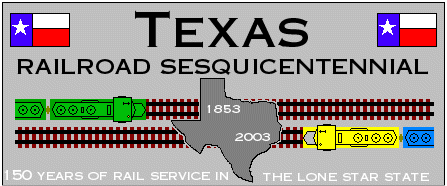This website has been archived from TrainWeb.org/southwestshorts to TrainWeb.US/southwestshorts.
This website has been archived from TrainWeb.org/southwestshorts to TrainWeb.US/southwestshorts.

| Texas Railroad Sesquicentennial - History of the BBB&C |
|---|
The Buffalo Bayou, Brazos and Colorado -
(This story originally appeared in the October 2003 issue of Gulf Coast Railroading ,
the official newsletter of the Gulf Coast Railroad Museum and Gulf Coast Chapter -
NRHS, Inc.)
Texas' First Railroad
by Howard Laker, Historian
Gulf Coast Chapter - National Railway Historical Society, Inc.
The month of September 2003 marked the sesquicentennial of the beginning of railroad
operations in the State of Texas. On September 7, 1853, the Buffalo Bayou, Brazos and
Colorado Railway Company began operating between Harrisburg, now a part of the City of
Houston, and Stafford's Point, now known as Stafford. With this, the BBB&C became not
only the first railroad to operate in Texas, but the first standard gauge line built
west of the Mississippi River. It was the second railroad west of the Mississippi
River, and the oldest component of the Southern Pacific Railroad until the 1990's,
when SP acquired lines that allowed it to reach Chicago.
Transportation in early Texas, like in many other places, was a major problem. Most
roads were little more than rutted dirt pathways, muddy during wet weather, dusty when
dry. Travel was slow, and also expensive. In 1840 a pound of coffee cost twice as much
in Austin as it did in Houston, mainly due to high transportation costs. Transportation
by water was cheaper, but although steamboats were common on a number of rivers, most
Texas rivers were unreliable. They had too much water at some times of the year, not
enough water other times, and sandbars and log jams. Railroads held the promise of
greatly improving transportation in the future.
The Republic of Texas granted four charters to build railroads, the first one in 1836,
less than ten years after the first public railroad in the United States was chartered.
However, none of the companies were able to construct a railroad.
One of them, the Harrisburg and Brazos Rail Road, was planned in 1839 by Andrew Briscoe,
the first chief justice (county judge) of what is now Harris County. It was to run from
Harrisburg, on Buffalo Bayou, to the Brazos River at Richmond, a rich agricultural area.
Briscoe was agent for the Harrisburg Town Company, and revenue from sales of lots in
Harrisburg was to be used to help finance the line. About two miles had been graded and
laid with ties when the project was abandoned in 1840.
Successor to the Harrisburg and Brazos, the Harrisburg Rail Road and Trading Company was
chartered in 1841 with Briscoe as president. It was also unsuccessful.
Sidney Sherman, a hero of the Battle of San Jacinto, allied with a group of Boston
capitalists, acquired the Harrisburg Town Company, which led to the Buffalo Bayou,
Brazos and Colorado Railway Company being chartered on February 11, 1850. It was
incorporated by Sherman, his group of Boston investors, and others, including William
Marsh Rice, a Houston merchant later to become a millionaire and the benefactor of what
is now Rice University.
Construction began in 1851, along the route of the earlier-surveyed line from Harrisburg
towards the Brazos River, and proceeded steadily, at a cost of $18,400 per mile. Stafford's
Point, a settlement that had grown up around the plantation of William Stafford, twenty miles
from Harrisburg, was reached in August 1853.
On September 7, 1853, for the first time in Texas, operations began. The
Galveston News
reported in September 1853 that the train would run between Harrisburg and Stafford's Point
each Wednesday and Saturday. By January 1, 1856, the BBB&C finally reached the east bank of
the Brazos River across from Richmond. In December 1857 the Houston
Tri-Weekly Telegraph
reported there were no boats on the Brazos River, since the railroads were handling all of
the business.
In 1868 and again in 1870, the BBB&C was sold, and later in 1870 the Galveston, Harrisburg and
San Antonio Railway Company was incorporated as a reorganization of the BBB&C. The line kept
extending westward, until in 1883 it met construction forces building from El Paso at a point
227 miles west of San Antonio, completing the Sunset Route from New Orleans to California.
In 1885 the GH&SA was leased to the Southern Pacific. Now owned by the Union Pacific
Railroad, the route of the Buffalo Bayou, Brazos and Colorado, Texas' first railroad,
is heavily used today and still an important railroad line.
Bibliography:
David M. Bernstein, The Complete Guide to Southern Pacific Operations in Texas (1993).
Stephen L. Hardin, "Stafford, TX." The Handbook of Texas Online.
Margaret Swett Henson, "Harris County." The Handbook of Texas Online.
David G. McComb, Houston: A History
(Austin: University of Texas Press, 1981).
Lewis W. Newton, "Briscoe, Andrew." The Handbook of Texas Online.
George C. Werner: "Buffalo Bayou, Brazos and Colorado Railway."
The Handbook of Texas Online.
George C. Werner, "Railroads." The Handbook of Texas Online.